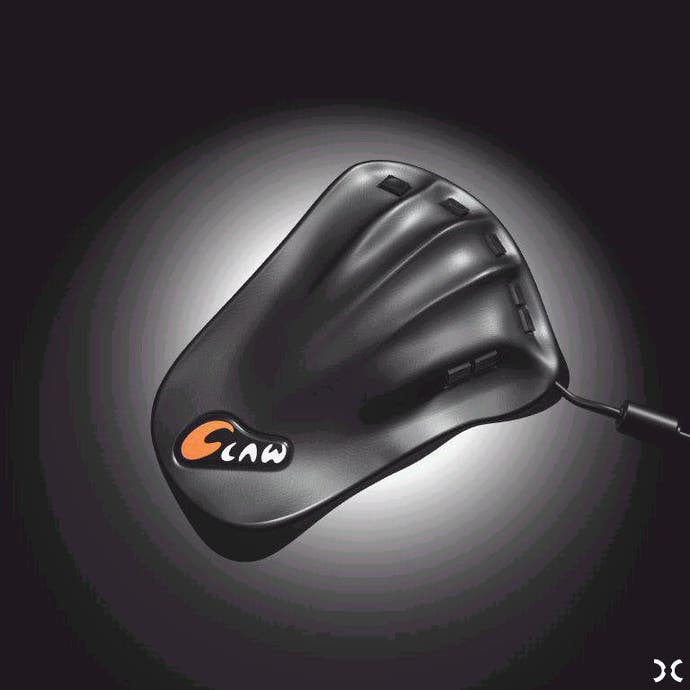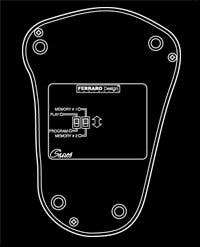The Claw
Review - a revolutionary new controller, or an impressive hand shaped paper weight?
- Ferraro DesignPrice - $59.99 AUS

The Claw!!
If you play first person shooters regularly you will likely be an advocate of the keyboard and mouse control combination. The most famous configuration, mouse for shooting and directional movement and the keyboard for movement keys, jumping, crouching and cycling weapons, is also one of the easiest to get used to, and it's a testament to its popularity that nowadays most shooters are developed with it in mind. The mouse has of course come on leaps and bounds since the days of Doom, with many gamers now flocking to some brand of optical device, or Razer's Boomslang, but the humble keyboard was never created with the gamer in mind, and as such many companies are now working on alternative devices for the gamer's other hand, with the intention of doing away with the keyboard completely, except for in-game chat. One of the most recent additions to the gaming keyboard-replacement market is a device from little-known Australian outfit Ferraro Design called "The Claw". It's a simple device that you place your hand upon very much like a claw, with a button for each finger tip (two for the index finger) and four buttons for the thumb. The idea is to allow movement to be controlled by the fingers and things like weapons switching, radio binds and other control keys to be dealt with by the thumb buttons. The approach is logical, and the design is quite polished.

Ergocentric?
It seems that Ferraro's primary incentive with "The Claw" has been to make it ergonomically fit the shape of your hand. Their curvaceous design is pretty universal, with moulded areas for the fingers and a raised arch on the right to rest your wrist upon. Ultimately this proved quite comfortable, despite initial concerns I had about the possibility of an arch jutting up into your wrist proving dangerous after prolonged use. Thankfully this isn't the case, but "The Claw" certainly isn't without its problems. Firstly, the install procedure. Obviously I was expecting some sort of USB connection to allow for ease of use, but the Claw uses a bizarre PS2 configuration. You take out your keyboard's PS2 adapter (or AT, depending on model), and then plug in The Claw's adapter. The adapter has two ends, one is PS2, one is AT, so you can use either standard. You then plug the keyboard back, but into a connected cable rather than your PC, so the keyboard cable actually hangs loose connected to an adjacent cable. It took me a few seconds to get my head around this, and of course all of this has to be done with the PC off because you can't hot-swap PS2. Wasn't USB invented to negate the need for this sort of thing? Regardless, soldiering on, I fixed everything up, and booted my computer. The Claw beeps to signify that it's operational, and then I got into Windows .. and nothing else happened. Consulting the instructions, I discovered that The Claw needs no extra drivers to work, and so, pleasantly surprised, I set about using it.

Gaming!
The first thing to do is program The Claw. You can't just jump into a game and configure it, it has to act as a mirror of keyboard functions (hence the elaborate passthrough installation). It has two memory banks, and you can either assign your game's configuration to the pre-defined keys (a, b, c, d, etc), or program them to mirror your config. I preferred this latter option, as I didn't want to mess with my config. I thought I'd start by programming it to deal with my Counter-Strike configuration. To program multiple keystrokes (which is what I needed to do), you put the left switch to "Program", and The Claw emits a continuous tone. You then press a button on The Claw and it beeps, then an appropriate key on the keyboard that you wish to assign, and it goes back to a continuous tone. You keep doing this until you are happy, then switch it back to Play. My configuration was a bit messy, because I realised quite soon that my usual backpedal key, S, lay below the forward key, W, and yet my middle finger control on The Claw only had one button. Short-sighted. In the end I used one of my thumb buttons, but this was uncomfortable. Playing CS proved somewhat difficult at first as I wrestled with the controls, but as I progressed things gradually got back to normal. The buttons aren't as instantaneously responsive as the keyboard, which is a real shame, but strafing and moving forward was easy enough. Nonetheless I couldn't really backpedal and perform another thumb-controlled function at the same time. The button for my little finger was used for crouching, and the four thumb buttons were spread between the "Enemy Spotted" radio command, jumping, backpedalling and using. Weapon-switching was fine, since I use the mousewheel for that.

How it felt…
After a while, things became a lot easier than they had been. I still had to reach for the keyboard for further radio binds, which rather spoilt the experience, but in games that required less team communications (and indeed in single player games including Quake 2), I was quite impressed by The Claw. After a while the contours on The Claw's design start to dig into your hand somewhat if you grip it tightly, which isn't terribly pleasant, but if you angle it correctly it's fine. The coarse rubber pads on the underside keep it in position, so it's just a case of occasionally adjusting your position. One of the most interesting things The Claw has in its favour is the way it allows you to sit with your hands closer together as if you were typing. The effect is actually a more comfortable gaming posture, and may eventually (when this new idea is developed a bit more for the first person genre) prove more popular than the keyboard and mouse option. At the moment though, despite The Claw's obvious benefits, it just isn't that essential a piece of equipment.
Conclusion
Although it does offer a dedicated gaming controller, to be fair the only thing "The Claw" has over a keyboard is that it doesn't feature a Windows key to accidentally nudge. With the mouse, it is what it is, an essential piece of equipment and irreplaceable; you need a good mouse to get the most out of your gaming and Windows use. With the keyboard however, it's already a perfectly serviceable tool, and a replacement like this is rather frivolous, and when it lacks a couple of important features like a decent key for backpedalling and a scrollwheel of sorts for weapon switching, the need for it is greatly reduced. A good try, but it needs a drastic overhaul, USB support and other options before it can really be taken seriously, especially when Microsoft have a very similar device that does far more with many of the missing perks for about the same price. A missed opportunity.

